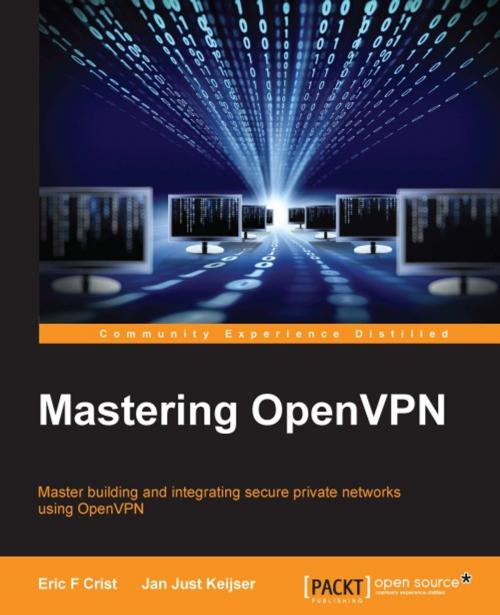Mastering OpenVPN
Nonfiction, Computers, Networking & Communications, Network Protocols, Application Software, Computer Security| Author: | Eric F Crist, Jan Just Keijser | ISBN: | 9781783553143 |
| Publisher: | Packt Publishing | Publication: | August 28, 2015 |
| Imprint: | Packt Publishing | Language: | English |
| Author: | Eric F Crist, Jan Just Keijser |
| ISBN: | 9781783553143 |
| Publisher: | Packt Publishing |
| Publication: | August 28, 2015 |
| Imprint: | Packt Publishing |
| Language: | English |
Master building and integrating secure private networks using OpenVPN
About This Book
- Discover how to configure and set up a secure OpenVPN
- Enhance user experience by using multiple authentication methods
- Delve into better reporting, monitoring, logging, and control with OpenVPN
Who This Book Is For
If you are familiar with TCP/IP networking and general system administration, then this book is ideal for you. Some knowledge and understanding of core elements and applications related to Virtual Private Networking is assumed.
What You Will Learn
- Identify different VPN protocols (IPSec, PPTP, OpenVPN)
- Build your own PKI and manage certificates
- Deploy your VPN on various devices like PCs, mobile phones, tablets, and more
- Differentiate between the routed and bridged network
- Enhance your VPN with monitoring and logging
- Authenticate against third-party databases like LDAP or the Unix password file
- Troubleshoot an OpenVPN setup that is not performing correctly
In Detail
Security on the internet is increasingly vital to both businesses and individuals. Encrypting network traffic using Virtual Private Networks is one method to enhance security. The internet, corporate, and “free internet” networks grow more hostile every day. OpenVPN, the most widely used open source VPN package, allows you to create a secure network across these systems, keeping your private data secure. The main advantage of using OpenVPN is its portability, which allows it to be embedded into several systems.
This book is an advanced guide that will help you build secure Virtual Private Networks using OpenVPN. You will begin your journey with an exploration of OpenVPN, while discussing its modes of operation, its clients, its secret keys, and their format types. You will explore PKI: its setting up and working, PAM authentication, and MTU troubleshooting. Next, client-server mode is discussed, the most commonly used deployment model, and you will learn about the two modes of operation using "tun" and "tap" devices.
The book then progresses to more advanced concepts, such as deployment scenarios in tun devices which will include integration with back-end authentication, and securing your OpenVPN server using iptables, scripting, plugins, and using OpenVPN on mobile devices and networks.
Finally, you will discover the strengths and weaknesses of the current OpenVPN implementation, understand the future directions of OpenVPN, and delve into the troubleshooting techniques for OpenVPN.
By the end of the book, you will be able to build secure private networks across the internet and hostile networks with confidence.
Style and approach
An easy-to-follow yet comprehensive guide to building secure Virtual Private Networks using OpenVPN. A progressively complex VPN design is developed with the help of examples. More advanced topics are covered in each chapter, with subjects grouped according to their complexity, as well as their utility.
Master building and integrating secure private networks using OpenVPN
About This Book
- Discover how to configure and set up a secure OpenVPN
- Enhance user experience by using multiple authentication methods
- Delve into better reporting, monitoring, logging, and control with OpenVPN
Who This Book Is For
If you are familiar with TCP/IP networking and general system administration, then this book is ideal for you. Some knowledge and understanding of core elements and applications related to Virtual Private Networking is assumed.
What You Will Learn
- Identify different VPN protocols (IPSec, PPTP, OpenVPN)
- Build your own PKI and manage certificates
- Deploy your VPN on various devices like PCs, mobile phones, tablets, and more
- Differentiate between the routed and bridged network
- Enhance your VPN with monitoring and logging
- Authenticate against third-party databases like LDAP or the Unix password file
- Troubleshoot an OpenVPN setup that is not performing correctly
In Detail
Security on the internet is increasingly vital to both businesses and individuals. Encrypting network traffic using Virtual Private Networks is one method to enhance security. The internet, corporate, and “free internet” networks grow more hostile every day. OpenVPN, the most widely used open source VPN package, allows you to create a secure network across these systems, keeping your private data secure. The main advantage of using OpenVPN is its portability, which allows it to be embedded into several systems.
This book is an advanced guide that will help you build secure Virtual Private Networks using OpenVPN. You will begin your journey with an exploration of OpenVPN, while discussing its modes of operation, its clients, its secret keys, and their format types. You will explore PKI: its setting up and working, PAM authentication, and MTU troubleshooting. Next, client-server mode is discussed, the most commonly used deployment model, and you will learn about the two modes of operation using "tun" and "tap" devices.
The book then progresses to more advanced concepts, such as deployment scenarios in tun devices which will include integration with back-end authentication, and securing your OpenVPN server using iptables, scripting, plugins, and using OpenVPN on mobile devices and networks.
Finally, you will discover the strengths and weaknesses of the current OpenVPN implementation, understand the future directions of OpenVPN, and delve into the troubleshooting techniques for OpenVPN.
By the end of the book, you will be able to build secure private networks across the internet and hostile networks with confidence.
Style and approach
An easy-to-follow yet comprehensive guide to building secure Virtual Private Networks using OpenVPN. A progressively complex VPN design is developed with the help of examples. More advanced topics are covered in each chapter, with subjects grouped according to their complexity, as well as their utility.















